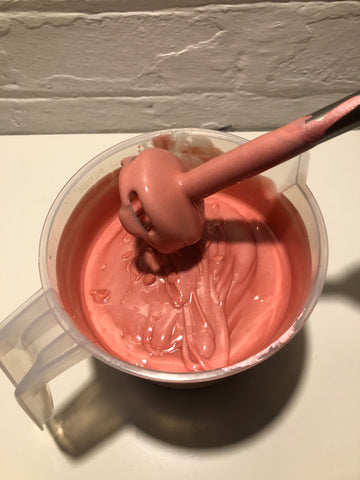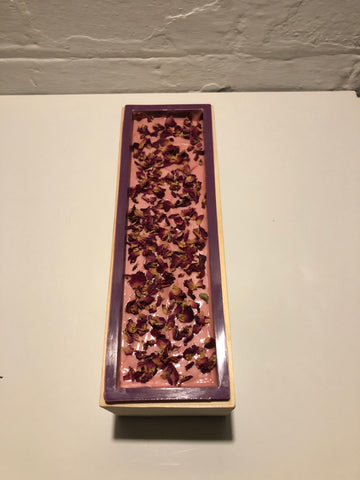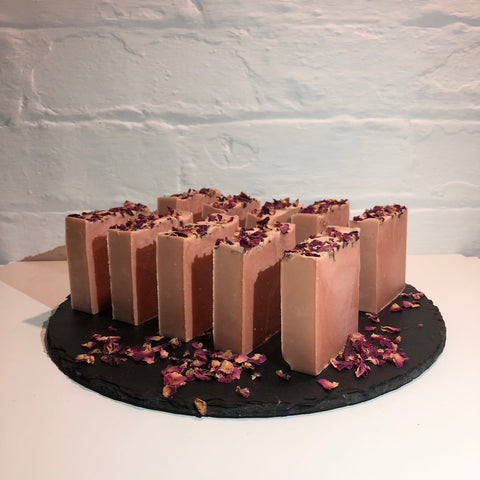Summer is nearly here! The promise of sunshine, warm summer nights and a garden full of flowers is just around the corner.
We've noticed that the rose buds are almost ready to burst open with colour, and we're excited to wander into the garden and smell that quintessentially English fragrance in the air.
To celebrate everyone's favourite flower, the rose, we have created a beautiful rose soap recipe to share with you. We've used rose absolute 5% dilution for a natural fragrance and dried rose petals from our new Botanicals collection to add a pretty decoration to these lovely pink-hued rose soaps.
This rose soap recipe can also be customised with our silicone soap moulds! We have a range of different shapes including a floral mould!
Why make rose soap?
Aside from the absolutely beautiful smell of course! We love making our own soap, you get about 10 bars from one recipe, which means not only does it work out as good value (keeping the bank manager happy!), it means you have a great supply on-hand and won’t find yourself running out.
All the ingredients in our rose soap recipe are natural and don’t include the harsh chemicals that go into commercial soap.
Our rose soap recipe provides numerous skin benefits, keeping your skin happy and of course it is kinder to the environment too.
Keep reading to discover how to make rose soap.
What skin type does rose soap suit?
Our natural rose soap recipe is so gentle it is perfect for all skin types. Its moisturizing properties make it suitable for everyone, from keeping by the sink for grubby hands to using as a body or face soap in the shower. You’ll find it mild enough for everyday use.
If you’re using soap on your face we always recommend you follow up with a moisturiser such as our rosehip face oil recipe to hydrate and nourish.
What is Rose Absolute 5% Dilution?
Absolutes are slightly different to essential oils in the way that they are made. They are still 100% natural, but rose essential oil is very hard to extract from the flower petals.
A different method is used to get these precious oils out where the usual methods for creating an essential oil such as steam distillation would be ineffective and not gentle enough for the delicate petals.
Absolutes are usually more potent than essential oils, you know that essential oils go a long way and this is even more true for absolutes! This means that they can be diluted.
Our rose absolute is diluted to 5% in sunflower oil so that you can benefit from the beautiful rose scent without the incredible price tag of 100% pure rose absolute.
Our rose absolute 5% dilution is 100% natural with no synthetic fragrances added.
Equipment:
To make our rose soap recipe, you will need:
- Gloves
- Goggles
- Digital scales
- Digital thermometer
- Stick blender
- Soap mould or DIY alternative
- Silicone spatula
- Heatproof bowl
- Plastic measuring jugs, ideally 2x 1L and 1x 2L
Ingredients:
This rose soap recipe uses various carrier oils to provide moisturizing and nourishing properties:
- Olive oil pomace 360g | 395ml
- Cocoa butter 270g
- Babassu oil 270g
- Water 297g
- Sodium hydroxide 126g
- Rose absolute 5% 28g | 30ml
- Blushed pink mica powder 20g
- Rose petals 10g
Method:
1. Mix the sodium hydroxide solution
- Put your gloves and goggles on before preparing the lye solution.
- Open the window, the fumes are unpleasant.
- Weigh the sodium hydroxide
- Weigh the water
- Add the sodium hydroxide to the water, not the other way around
- Mix well until combined. Careful, it will get hot!
- Leave to cool
2. Weigh and heat the oils
- Weigh the olive oil, cocoa butter and babassu oil into a heatproof bowl
- Heat gently above a pan of boiling water, or using short bursts in the microwave
- Stir regularly until completely melted
- Once melted, leave to cool.
- In a separate jug, weigh the rose absolute.
- Weigh the pink mica powder, and mix with the rose absolute
3. Test the temperatures
- Test the temperature of the sodium hydroxide solution. It should be between 25C and 40C.
- Leave it to cool if necessary, but don't reheat it if it's too cool.
- Test the temperature of the oil mixture. It should be between 35C and 40C.
- Leave it to cool or reheat if necessary.
- Once the temperatures are correct, add the sodium hydroxide solution to the oil mixture.
4. Blend until trace
- Stir with the hand blender, and blend with short pulses.
- Watch for the soap batter starting to thicken.
- Test for trace by dripping soap batter on the surface of the mixture. If the drips sit on the surface before disappearing, your mixture has reached trace.
- Stop blending once your soap mixture has reached trace.
- Add the rose absolute.
- Mix and blend a little until combined.
5. Pour into moulds
- Pour your soap moulds.
- Tap on the work surface to get rid of air bubbles.
- Sprinkle the dried rose petals on top of your soap mixture
- Insulate with towels.
- Leave on a flat surface for 48 hours
6. Leave to cure
- Unmould your rose soap.
- Place bars with a space in between.
- Leave to cure for 4-6 weeks
Carry On Reading
Now that you've learned how to make homemade rose soap are you eager to try more? We've got dozens of gorgeous natural skincare, haircare and soap recipes ready for you to try!
- Want to learn more about cold process soap making? Try our beeswax soap recipe.
- Why not try a melt and pour soap recipe? They are as easy as 1-2-3! We love this tea tree melt & pour recipe for it's fresh herbal scent.
- Interested in hot process soap making? Try our easy hot process soap recipe
- Want to make palm free soap? Check out our cold process soap recipe without palm.
How did you homemade rose soap turn out? Comment below and let us know.










2 comments
It certainly is, be sure to let us know how the recipe works for you!
Can’t wait to make this rose soap ,looks beautiful